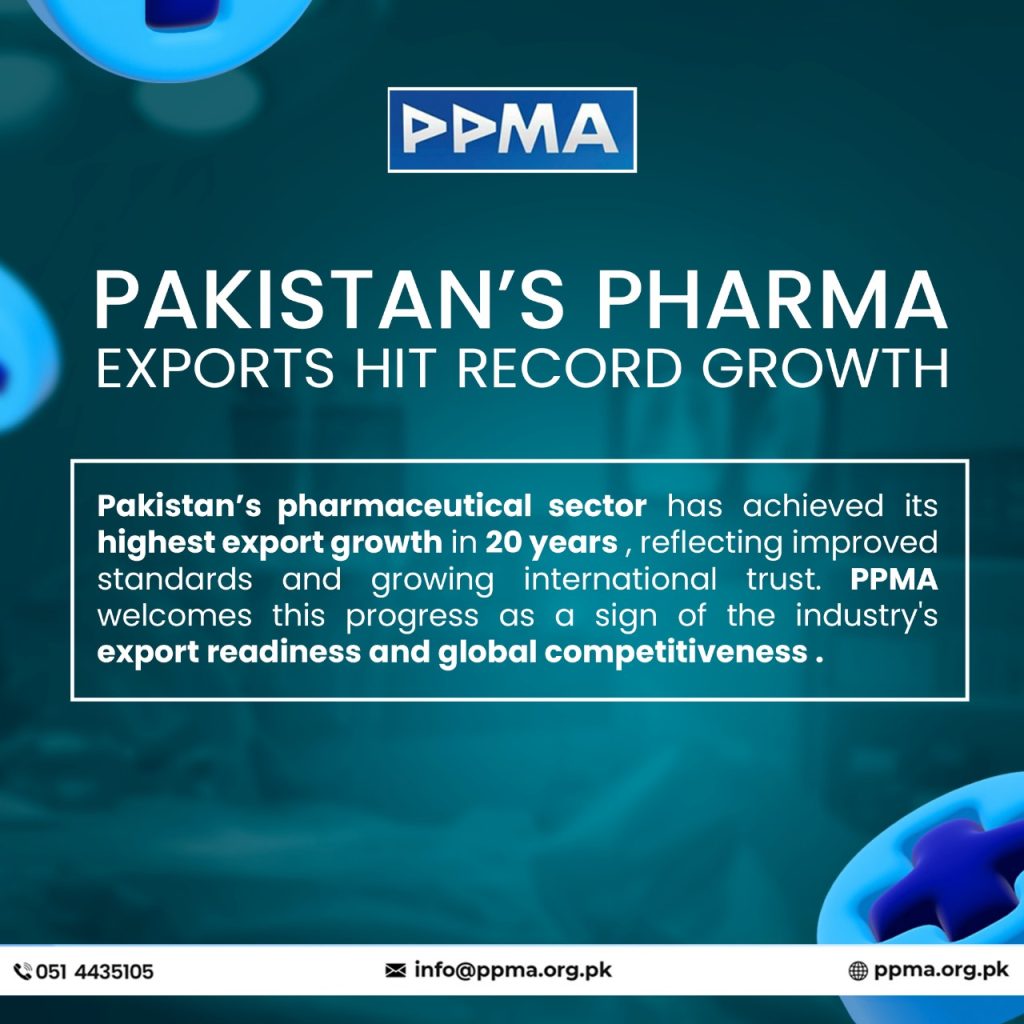Pakistan’s pharmaceutical industry has achieved a historic milestone, with pharmaceutical exports soaring by 34% in the fiscal year 2024-2025 (FY25) — the highest growth recorded in over 20 years. According to data released by the Pakistan Pharmaceutical Manufacturers’ Association (PPMA), the country’s pharma exports reached $457 million, up from $341 million in FY24.
This remarkable progress has positioned the pharmaceutical sector as the fifth fastest-growing export category in the country, signaling a new era of international expansion and market confidence in Made-in-Pakistan medicines.
A Record-Breaking Year for Pakistan Pharma Exports
The 34% year-on-year growth marks the highest ever surge in pharma exports since 2009, when the previous best of 32% was recorded. This performance reflects a combination of favorable government policies, improved regulatory frameworks, and renewed industry focus on export-led growth.
According to PPMA Chairman Tauqeer Ul Haq, this exceptional performance has been largely driven by the government’s deregulation policy, announced in February 2024, which allowed for market-based pricing of non-essential medicines.
“This pricing policy aligned Pakistan with international pharmaceutical practices, encouraged new investments, and increased access to affordable medicine. It also helped curb black-market practices,” said Haq.
Total Therapeutic Goods Exports Near $1 Billion
Beyond pharmaceuticals, Pakistan’s broader therapeutic goods exports — including surgical instruments, nutraceuticals, medical devices, and food supplements — reached $909 million in FY25. This puts the sector just $91 million short of crossing the symbolic $1 billion mark.
This shows how Pakistan’s pharmaceutical industry is becoming a key player in the global therapeutic goods market, especially in emerging economies that are seeking affordable and quality healthcare products.
PPMA’s Role in Strengthening the Industry
The Pakistan Pharmaceutical Manufacturers’ Association (PPMA) has played a vital role in facilitating dialogue between the government and industry stakeholders. Through continuous advocacy for policy reforms and export incentives, PPMA has helped the local industry gain momentum in international markets.
Additionally, the association encourages the localization of raw material production such as APIs (Active Pharmaceutical Ingredients), vaccine manufacturing, and research investments all crucial for self-reliance and import substitution.
Market Expansion: From Afghanistan to Africa
Speaking at the International Center for Chemical and Biological Sciences (ICCBS), University of Karachi, industry expert Syed Hassan Arsalan, representing The Searle, highlighted that Afghanistan remains the top destination for Pakistan Pharma Exports, followed by the Philippines, Sri Lanka, Uzbekistan, and French West Africa.
“Iraq is a growing market, and we’re seeing strong responses from Kenya, Vietnam, Myanmar, and Thailand as well,” Arsalan added.
This geographic expansion demonstrates the increasing global reach and competitiveness of Pakistan Pharma Exports in less regulated and emerging pharma markets across Asia and Africa.
Pharma Exports: Tapping into the $600 Billion Generic Drug Market
According to Nadeem Rahmat of PharmaEvo, the global pharmaceutical market is projected to reach $1.5 trillion by 2030, with generic medicines accounting for $600 billion of that total. This represents a massive untapped opportunity for Pakistani pharma exports, particularly in the generics segment.
“We need to invest in quality manufacturing and regulatory compliance to capture our fair share of the global generics market,” Rahmat emphasized.
Challenges and Opportunities in Pakistan Pharma Exports
Despite this progress, Pakistani pharmaceutical exports still contribute only about 5-7% to the total revenue for most domestic pharma companies, as noted by Muryum Palekar, an analyst at Optimus Capital Management.
She noted that while Pharma Exports are currently focused on low-regulated markets, this serves as a stepping stone toward accessing higher-regulated regions — provided the industry enhances quality control, secures international certifications (e.g., WHO-GMP, USFDA, EMA), and invests in research and development.
“As countries like India and China shift their focus toward R&D, Pakistan has a unique chance to step up as a reliable generics supplier for low- and middle-income countries (LMICs),” said Palekar.
Looking Ahead: Local Production and the Future of Pharma Exports
With continued support from PPMA, progressive policies, and private-sector investment, Pakistan’s pharmaceutical industry is poised to become a regional leader in pharma exports. Future initiatives include:
-
Local production of vaccines
-
Manufacturing of APIs to reduce import dependency
-
Expansion into high-growth international markets
These steps will not only boost exports but also contribute to national health security and economic development.
Conclusion
The pharmaceutical export growth of 34% in FY25 is a testament to the resilience, innovation, and strategic foresight of Pakistan pharmaceutical industry. With PPMA’s leadership, strong policy backing, and increasing global demand for affordable generics, the country stands on the brink of a Pakistan pharma export revolution.
Pakistan’s next goal: crossing the $1 billion export mark — and beyond.


